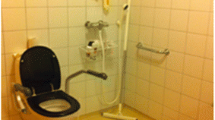Abstract
People with a temporary or permanent physical impairment are often excluded from bathing activities due to the difficulties of getting in and out of the water. This paper explores pool design, specifically the design of the access to the tank, which is the key to pools’ inclusivity. In trying to break down existing barriers between users, accessibility experts and designers, we interviewed physically impaired architects about their perception of four types of pool access often used by wheelchair users: ramps, transfer walls, transfer systems and lifts. The interviews revealed limitations in all four types of pool access. To compensate for the limitations identified, combining different types of access in one single pool may be of interest. Moreover, the interviews allowed the identification of another type of pool access, designed by one of the interviewees: an upper pool border connected to an underwater bed and seat allows for an easier exit than transfer walls and transfer systems. Another interviewee advanced the idea of a cane holder for physically and visually impaired people, which may contribute to freeing poolside floors from obstacles and reducing the risk of falls. These insights may contribute to making pools more inclusive, by accommodating specific temporary or permanent mobility needs of all of us.
Access this chapter
Tax calculation will be finalised at checkout
Purchases are for personal use only
Similar content being viewed by others
References
Caden J (2011) How to apply the Americans with disabilities act. World Aquatic Health conference, Colorado Springs, CO, US, 18–20 October 2017
Denzin NK, Lincoln Y (2011) The SAGE handbook of qualitative research. SAGE
DJ (2010) 2010 ADA standards for accessible design. Department of Justice, Washington, DC, US
Fletcher V (2009) Universal design and multi-sensory environments. Art beyond sight conference, metropolitan museum of art (oral presentation), New York, NY, US
Flick U (2009) An introduction to qualitative research. SAGE
Guimarães MP (2011) Writing poetry rather than structuring grammar: Notes for the development of universal design in Brazil. In: Preiser WFE, Smith KH (eds) Universal design handbook, McGraw-Hill, pp. 14.1–14.9
Howard L, Young LC, Figoni SF (2008) Removing barriers to health clubs and fitness facilities. The Center for Universal Design, Raleigh, NC, US
Middlestadt SE, Anderson A, Ramos WD (2015) Beliefs about using an outdoor pool: Understanding perceptions of place in the context of a recreational environment to improve health. Health Place 34:1–8
Ostroff E (1997) Mining our natural resources: The user as expert. Innov 16(1):33
Ostroff E, Limont M, Hunter DG (2002) Building a world fit for people: Designers with disabilities at work. Adaptive Environments Centre, Boston, MA, US
Pérez Liebergesell N, Vermeersch P, Heylighen A (forthcoming) Designing from a disabled body: the case of architect Marta Bordas Eddy. Multimodal Technologies and Interaction
Sato D, Kaneda K, Wakabayashi H, Nomura T (2007) The water exercise improves health related quality of life of frail elderly people at day service facility. Qual Life Res 16(10 Dec): 1577–1585
SE (2002) Access for disabled people. Sport England, London, UK
Story MF, Mueller JL, Mace R (1998) The universal design file: Designing for people of all ages and abilities. The Center for Universal Design, Raleigh, NC, UK
USAB (2004) Americans with disabilities act and architectural barriers act accessibility guidelines. United States Access Board, Washington, DC, US
Usandizaga M (2013) Learning about universal design: An experience. In: Bordas-Eddy M (ed) Let’s open cities for us—LOCUS. Universitat Politècnica de Catalunya, Barcelona, Spain, pp 17–23
Vermeersch PW, Heylighen A (2011) Scaling haptics – Haptic scaling. Studying scale and scaling in the haptic design process of two architects who lost their sight. In: Adler G. et al. (eds) Scale: Imagination, perception and practice in architecture, Routledge, pp. 127–135
Vermeersch PW, Heylighen A (2013) Rendering the tacit observable in the learning process of a changing body. In: Nimkulrat N et al (eds) Knowing inside out. Loughborough University, Loughborough, UK, pp 259–270
Acknowledgements
This research was supported by Fundação para a Ciência e a Tecnologia, reference SFRH/BPD/94371/2013, with joint funding from Portugal and the European Union. We are grateful to Isabella Steffan, Ivor Ambrose, Ljerka Gordić, Sonia Carpinelli and Valerie Fletcher, for their contribution to the interviewees sample, and Daniel C. Gaspar, David M. Correia and Pedro O. Teixeira, for the visual assistance to the first author, a blind person.
Author information
Authors and Affiliations
Corresponding author
Editor information
Editors and Affiliations
Rights and permissions
Copyright information
© 2018 Springer International Publishing AG
About this paper
Cite this paper
Pereira, C.M., Heitor, T.V., Heylighen, A. (2018). Improving Pool Design: Interviewing Physically Impaired Architects. In: Langdon, P., Lazar, J., Heylighen, A., Dong, H. (eds) Breaking Down Barriers. CWUAAT 2018. Springer, Cham. https://doi.org/10.1007/978-3-319-75028-6_7
Download citation
DOI: https://doi.org/10.1007/978-3-319-75028-6_7
Published:
Publisher Name: Springer, Cham
Print ISBN: 978-3-319-75027-9
Online ISBN: 978-3-319-75028-6
eBook Packages: EngineeringEngineering (R0)




